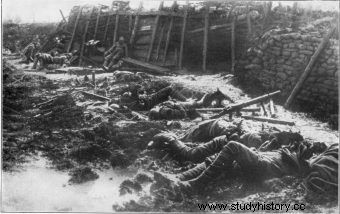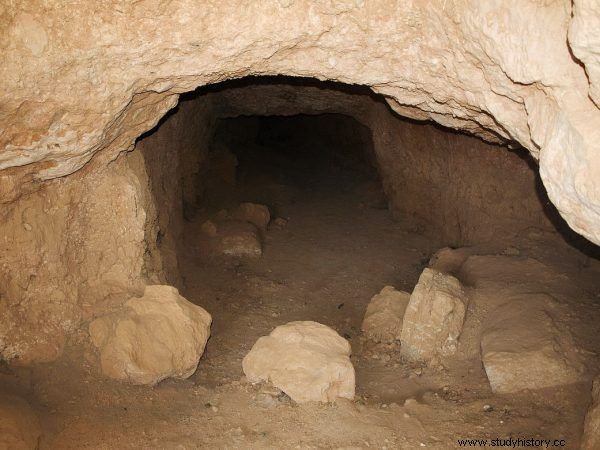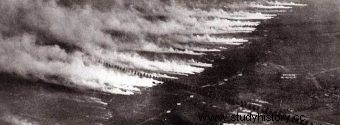It is said that necessity is the mother of invention. Unfortunately, but also in the context of bloody armed conflicts. The tools of extermination changed from time to time, and although chemical weapons began to be used on a larger scale during World War I, traces of bioterrorism were recorded in the distant past.
Animal Venom, Aeneas Tactic's War Guide
The war architecture is extremely complex. After all, we are talking about the preparation of appropriate fortifications, the use of the natural environment and terrain conditions, and finally the variable weather, factors that are difficult to predict. A certain Aeneas the Tactician, a writer and commander who lived in the 4th century BCE, the author of several textbooks on the art of war, was well aware of this.

Consequences of the gas attack during the Battle of Fromelles in 1916.
Ancient scientist, perhaps the first military theorist, at least recommended the use of animals in combat - bees, wasps, scorpions. Insects were sealed in clay pots and then thrown at the enemy. However, there were many more sources of natural poison.
Poisonous corridors of the underground city - Persians and their weapons
When was chemical weapons first used? It turns out that the ancients were able to use the knowledge we combine today in biology, chemistry and physics to increase the strength of their own arsenal. This was commanded by, among others, the Persians under the rule of the Sassanids, who during one of the battles waged against the Roman Empire had come up with a truly satanic idea.

Traces of the siege of Dura Europos on the Euphrates in 256. The attacking Persians dug an underground passage under the walls and let a mixture of bitumen and sulfur crystals through it
The theater of war was the city of Dura Europos, located in what is now Syria. There, too, perhaps for the first time in history, a completely new siege strategy was deliberately applied. All because the Persian army attacked the Romans with poisonous gas. However, the offensive had to be properly prepared.
At the very beginning, the Persians built a high embankment to make it easier for themselves to storm the defensive walls. Then they also decided to dig a tunnel leading under the city. Roman commanders decided to undertake a counteroffensive - create their network of tunnels. And there, too, the Sassanid army decided to unleash a deadly poison.
In the tunnels, bitumen (a component obtained during oil refining) was set on fire together with sulfur crystals. The vapors of this extremely deadly mixture penetrated through the excavation to the Roman side, creating a poisonous gas that brought death to the Roman unit on the front line. Research by modern archaeologists, including Professor Simon James of the University of Leicester, shows that the shape of the tunnel constructed by the Persians was supposed to favor the spread of poison underground. The strategy was therefore not a coincidence, but a well-crafted plan.
Humans Runaway Like Rats - Spartan Fire Trap
In 429 BC during the struggle during the Peloponnesian War Spartans besieging Plateje they decided to set fire to a mixture of wood, tar and sulfur outside the city walls. It quickly turned out that the toxic fumes forced the inhabitants to leave their defenses, who fled like rats from a sinking - though in this case a burning ship. It is mentioned by Thucydides, author of the "Peloponnesian War",
,, When the Lacedaemonians (remember that this is a common name for Periods and Spartans, peoples living around Sparta - editor's note) decided to try it or not the city that was small will be burned up by using the wind; because they were still thinking about somehow conquering the Plateje without spending and a regular siege, then there was such a great fire, which had never been ignited by a human hand before "'

Perhaps even more interesting, it is in time During the Peloponnesian War, prototypes of flamethrowers were used for the first time in military history. Let us again give the floor to Thucydides, who thus characterizes the machine;
They took a long beam, cut it lengthwise, hollowed out both halves and put it back together to form a pipe. At one end of the beam they hung a cauldron on chains. From the beam they led an iron funnel into it; moreover, most of the beam is also covered with iron ...
Later we learn that the air current that was supposed to pass through the machine started a fire that could destroy ancient fortifications.
However, a portable flamethrower with a modern design was patented by the German inventor Richard Fiedler in 1910. The effectiveness of the extermination tool was discovered on the battlefield in February 1915, when the Germans used their lethal weapon against the French troops at Malancourt. During World War I, chemical weapons were used on a larger scale, for which we can find irrefutable evidence in the chronicles.
A field of tears, sweat and blood - the living dead in the theater of World War I
It is believed that the first use of a new type of weapon by the Germans was on October 17, 1914 on the Western Front, this is not a date that has entered mass consciousness. All because the weapons used in the Neuve-Chapelle area, where German troops fired tear gas grenades at the Allied positions, did not turn out to be so effective. It was merely a scarecrow, a ghostly danger.
Soon after, already in 1917, the Germans, who had a better and better understanding of the destructive nature, used a completely new type of weapon. Mustard gas, called mustard gas, used during the famous attack at Ypres . The Belgian city was the site of four battles, the most terrifying of which was the second, when the Germans used chlorine as a poisonous warfare agent.
70,000 victims (killed or missing) have been reported on the side of the Entente countries and the battle changed the face of war. Because after the struggle, both sides began to equip their troops with special protective measures, hence no chemical attack was so deadly.

Chlorine chemical attack during World War I
It is also one of the agents belonging to the blistering agents category - the substance does not kill directly, while the damage caused by the chemical action of the mixture is so great that limits, indeed, actually paralyze the injured. Severe skin burns and a direct attack of the respiratory tract bring death in real torment. Survivors recalled that their comrades-in-arms - although still alive - were actually dead. The bodies of the injured began to turn blue quickly and frightening foam appeared in the mouth. The poison was taking its toll.
Necessity is said to be the mother of invention. Unfortunately, but also in the context of bloody armed conflicts. The tools of extermination changed depending on the eras, and although chemical weapons began to be used on a larger scale during World War I, traces of bioterrorism were recorded in the distant past.
The Spartan fire trap, the poisonous corridors of the underground city designed by Persians, and finally the deadly chlorine used by the Germans prove that chemical weapons are one of the most dangerous substances - elements in the theater of war activities.
